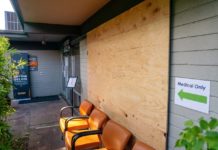The proposed Smart & Safe Arizona ballot initiative that will begin collecting signatures this month for placement on the 2020 ballot aims to decriminalize marijuana for adults aged 21 and over and expand the legal market from medical-only to adult-use. This latest attempt at legalizing adult-use marijuana will try to win over foes of 2016’s failed adult-use initiative by, among other provisions, granting cities and counties greater control over new marijuana establishments.
Stacy Pearson, spokesperson for the Smart & Safe Arizona campaign, said that the initiative would grant Sedona the power to regulate the number of adult-use marijuana establishments within city limits. The city could even opt to ban adult-use establishments, including growers and processors, and prohibit deliveries of adult-use marijuana within city limits. Yavapai and Coconino counties could do the same for unincorporated communities within their jurisdictions.
But there’s a significant exception to the new initiative’s appeal to local control: Existing medical dispensaries in good standing would have the right to apply for an adult-use sales permit co-located with the existing medical establishment. So in the case of Sedona, the city’s lone medical dispensary, Bloom Sedona in Uptown, could add adult-use sales, regardless of any actions by the City Council. Other activities legalized under the program, such as adults possessing less than an ounce of marijuana or growing up to six plants per adult on private property, would also be outside of local jurisdiction.
Local governments like Sedona and Yavapai County could, however, bar or limit adult-use establishments in new locations.
“Ultimately Sedona has control over how it wants to see adult use in Sedona,” Pearson said of the initiative’s proposed rules
Smart & Safe Arizona’s attempt at granting greater regulatory power to localities might reflect an attempt by the campaign to win over rural Arizona voters, who voted against adult-use in 2016 in far greater rates than the state’s urban counties.
Mikel Weisser, state director of the Arizona chapter of National Organization for the Reform of Marijuana Laws, said his focus in the upcoming campaign will be on rural outreach.
“There was very little attention given to ground game or even advertising outside of the Phoenix and Tucson-metro areas in 2016,” Weisser said. “So I started reaching out to what would be the new campaign [Smart & Safe Arizona] as soon as I could and said, ‘We need to make sure we’re addressing the ground game outside of Phoenix.’”
Other provisions in the 2020 adult-use initiative suggest that campaigners took that advice to heart.
Weisser and Pearson said they believe that the initiative’s plan for spending the estimated $300 million in marijuana excise tax dollars would distribute the benefits of these funds more equitably between rural and urban Arizona than previous initiatives.
Pearson said that whereas the 2016 initiative was focused on sending excise taxes to K-12 education [80 percent], two-thirds of the marijuana revenue from the Smart & Safe adult-use program would be split between roads and community colleges, both of which are seen as potentially having greater impact for rural communities than other schemes.
“One of the biggest priorities throughout Arizona is infrastructure.” Pearson said. “The HURF [Highway User Revenue Fund] … has been stagnant, and in fact the revenue source is declining. This new revenue, or about a third of the [marijuana tax] revenue … allows for that fund to stabilize and rural communities to start seeing funding in their communities again.”
Pearson also noted that both the chosen beneficiary of the initiative’s education dollars, community colleges, and the formula for distribution could mean rural communities see more impact from marijuana excise taxes, if the proposition is approved.
“A third of the funding goes to community colleges, and it’s a formula that both includes baseline funding, for some of the smaller rural schools and schools outside Maricopa and Pima, and then per-pupil funding in addition, and that would total about $100 million a year, which brings community colleges back to pre-recession level funding,” Pearson said.
But could tweaks in this latest adult-use initiative have an impact on voters in rural Arizona?
“I think it’s possible,” said Jesse Dowling, a local proponent of legalized marijuana and a member of the Cottonwood City Council from 2011 to 2015. But, he said, “I think the two sides are ensconced where they’re going to be. I think this initiative is really working on that middle 3 or 4 percent that wasn’t there the last time, because I think that a lot of [city and county] leadership positions will be afraid to vocally or obviously support it just because of the negative stigma that is still attributed to [marijuana].”
But Dowling believes that attitudes in Cottonwood are evolving, too, due to Arizona’s experience with its medical marijuana program and “things like having a cultivation site being in [Cottonwood] and the city’s not a flaming husk of its former self overrun by gang members with pot shops on every corner,” he said.
Scott Shumaker can be reached at 282-7795 ext 117 or by email at sshumaker@larsonnewspapers.com






















